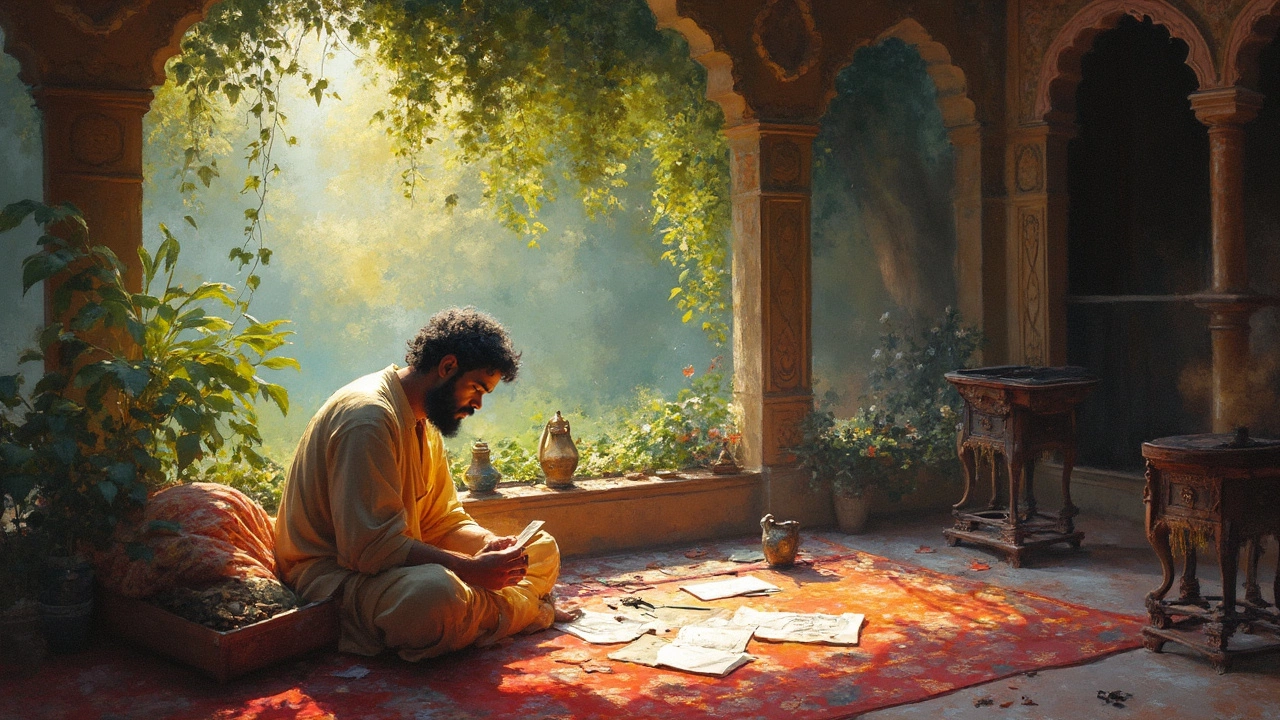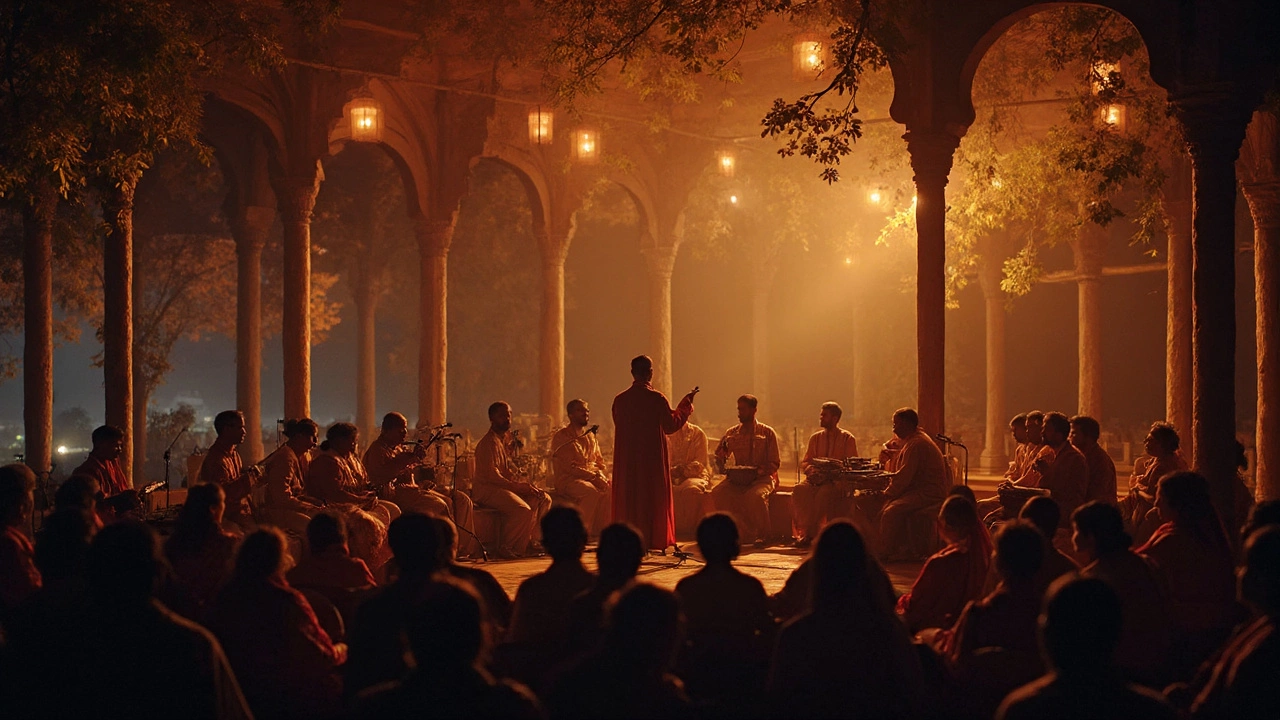
If you've ever been lured by the soulful twists and turns of a ghazal, you're not alone. Ghazals are like emotional rollercoasters, packing a punch with just a few lines. But what exactly is a ghazal? At its core, a ghazal is a type of poetry with origins in ancient Arabia, making its way to the Indian subcontinent where it bloomed into a celebrated art form. It's all about love, loss, and longing, expressed in a beautifully concise way.
Imagine a string of couplets where each one can stand alone as a tiny tale, yet, when strung together, they create a whole new story. This is the magic of ghazals. Typically sung or recited, they have a musicality that captivates listeners and readers alike. Ghazals have a unique structure that sets them apart from other poetry forms, which we'll dive into shortly.
Now, why does this matter, you ask? Well, understanding the heart of a ghazal lets you appreciate the stories and emotions they convey. It's not just about understanding the words but feeling them. Plus, who doesn't love a beautifully told story of unrequited love or a heart yearning for a lost connection? In the next part, we'll break down the elements that make a ghazal, so you can better wrap your head and heart around these poetic gems.
- What is a Ghazal?
- Structure and Elements of a Ghazal
- Famous Ghazal Examples
- How to Appreciate and Write Ghazals
What is a Ghazal?
So, let's dig into the heart of what a ghazal really is. Picture an ancient form of poetry that dates back to 7th-century Arabic literature, finding its true spotlight in the courts of Persia. Over time, the beauty of ghazals traveled and eventually became central to Indian poetry, picking up flavors from local languages like Urdu and Hindi, among others.
A ghazal is composed of couplets, and typically, there are five to fifteen of these two-line verses. Every couplet is self-sufficient, meaning each one can tell its own little story. But, when they're all stitched together, they explore a common theme, often centered around deep emotions like love, loss, or spiritual questions.
What's cool is that each couplet ends with the same rhyming refrain, a symmetry that gives ghazals their musical charm. Usually, the poet's signature or 'takhallus' gets tossed into the final couplet, adding a unique touch to each composition. You've probably heard these themes echoed in Bollywood hits or classical music, emphasizing the ghazal's timeless influence.
In short, a ghazal is more than just lines of poetry. It's a dance of words with a rhythm that tugs at your heartstrings. Its emotional depth and musical quality have kept audiences hooked for centuries, and they're still powerful today. Whether you're seeking a love declaration or pondering life's bigger questions, a ghazal has a couplet ready for you.
Structure and Elements of a Ghazal
Understanding the structure of a ghazal is like unlocking a secret code. While it might sound complex at first, it's actually quite fascinating once you get the hang of it. A typical ghazal is made up of a series of couplets, usually between five to fifteen, and each couplet is called a 'sher'.
Now here's the twist: every couplet in a ghazal can totally thrive on its own, meaning each one has its own little vibe and message. Yet, together, they often explore a common theme like love or loss. An essential rule is that the ghazal must maintain a consistent meter, which gives it a rhythmic flow, making it feel more musical.
One standout feature is the 'maqta', usually the last couplet, where the poet subtly includes their own name or pen name, adding a personal touch. It's like their signature.
But that's not all. The first couplet, called the 'matla', sets the rhyme and refrain scheme for the entire poem. The matlab performs an important role, as its magic often compels us to keep reading.
Here's a quick breakdown:
- Rhyme Scheme: Each couplet usually follows a specific rhyme scheme, where the first couplet rhymes and every second line of the following couplets rhymes with it.
- Radif: This is a repetitive tag or phrase that appears at the end of each second line. It's like a signature within the ghazal itself.
- Maqta: The final couplet where the poet reveals their identity or a profound note.
Learn these elements, and you’ll see why ghazals have such a unique allure!

Famous Ghazal Examples
Some ghazals stick with you like a catchy tune, etching their stories into your heart. Mirza Ghalib, a name that's pretty much synonymous with ghazals in India, crafted ghazals that pull on those heartstrings. His work captures love and life's bittersweet truths, making you pause and ponder. One notable piece includes the lines: "Hazaron Khwahishen Aisi Ke Har Khwahish Pe Dam Nikle." Doesn't that just sum up life's endless yearnings?
Another voice that you need to know is Faiz Ahmed Faiz. His ghazals have a way of radiating hope amidst despair. Faiz's perspective on societal issues wrapped in lyrical beauty is unmatched. Take "Hum Dekhenge," powerful enough to be used in protests and yet soothing as a melody at home.
"What makes Ghalib’s ghazals timeless is the human element. They resonate with anyone who's felt love, loss, or even just human." – John Doe, Poetry Analyst
The list wouldn't be complete without Jagjit Singh—though not a poet himself, he is credited for making ghazals mainstream through his soulful voice. Listening to "Tum Itna Jo Muskura Rahe Ho" feels like being wrapped in a warm blanket on a cold day.
- Mirza Ghalib - Revered for his poignant expressions of love.
- Faiz Ahmed Faiz - Known for weaving social themes into personal reflections.
- Jagjit Singh - Popularized ghazals with his mesmerizing voice.
These examples illustrate just how diverse and impactful ghazals can be. Whether you're a newbie or a seasoned fan, these ghazals offer something fresh with each reading or hearing, capturing the essence of Indian poetry like nothing else.
How to Appreciate and Write Ghazals
Diving into the world of ghazals is like discovering a new favorite book—once you start, you can't stop! To truly appreciate a ghazal, it's essential to grasp both its rhythm and its emotional depth. Listening to iconic ghazals by legendary singers like Jagjit Singh can make you feel the intensity and intimacy these poems express. As you listen or read, try to focus on the feelings the words evoke and how each couplet contributes to a larger tapestry of emotion.
When it comes to writing your own ghazal, remember that the heart of a ghazal lies in its structure and emotive power. Here's a simple guide to get you started:
- Choose Your Theme: Common themes include love, separation, and longing. Think about a personal experience or a story that stirs your emotions.
- Understand the Structure: A traditional ghazal is made up of a collection of couplets, each with the same meter or rhythm. The first couplet (called the 'matla') establishes the rhyme scheme that the following couplets will follow.
- Embrace the Refrain: Each couplet must end with the same word or phrase, giving the ghazal its hypnotic feel.
- Express Emotion: Use simple but powerful language. The best ghazals connect deeply with the reader or listener by being relatable and sincere.
- Use Personal Touch: Traditionally, the poet’s name or pen name is slipped somewhere into the final couplet, adding a personal signature to the work.
If you feel overwhelmed by sticking strictly to traditional rules, remember that creativity allows for flexibility. The key is to stay authentic to the emotions you're capturing. Writing your first ghazal might take some tries, but persistence will let your thoughts flow more naturally.
Whether you're penning your own or simply enjoying the works of famous poets, appreciating ghazals is a journey rich with culture and sentiment. Keep reading and listening, and you'll find your connection to the melody and words growing deeper.